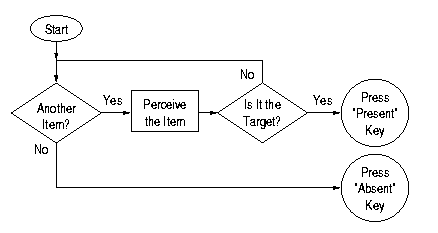These results can be accounted for by a process called serial
self-terminating search. A flow chart for this process is shown below:

|
|
Flow chart for serial exhaustive search.
|
The linear increase in RT is explained by the fact that for every
item added to the display, the process must go through the loop that
checks whether the item is the target. The double slope for
target-absent items is explained by the fact that all the
items must be checked when there is no target to be found, but if
there is a target present, then on average only half the
items must be checked until the target if found.
This theory emphasizes processing, and does not make strong
commitments about representation. It assumes that items are
represented in such a way that they can be separately attended to;
i.e., the format is in fact as separate items. But beyond that, the
theory doesn't specify whether the items are represented as templates
or features or structures or whatever.






 This experiment and theory
provide a good example of the knowledge organization emphasized in the
syllabus. See if you can fill in all the relevant information in the
diagram at left.
This experiment and theory
provide a good example of the knowledge organization emphasized in the
syllabus. See if you can fill in all the relevant information in the
diagram at left.